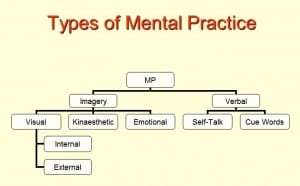Due to the restrictions of training at present the use of mental imagery will be incorporated. Lang (1977, 1979) states that Bioinformational theory concludes motor programming occurring while visualizing movement. This coordinates well with Bird (1984) who discusses psychoneuromusclar theory.
Lang (1979) observes the bodies’ electrical system within the nervous system while making a free throw in basketball and imagining the same throw. This suggests that there is muscle activation in the preliminary phases (before contraction) in imagination setting that mimic the participant’s free throws in real life. Like an electrical control unit in car. AKA learning motor unit recruitment and movement patterns before commencement.
Bird’s (1984) EMG study reveals imagery producing real stimuli, which are 2/3 of an action. This study takes mental practice into account.
(Crust, 2012, Lecture Notes)
An example of Imagery in Sport
This proves crucial to performance enhancment, this can be transfered to athetics for function of movements and sequeces used in sprinting to the more technical javelin throw.
In the next session, today at 6:30, the use of imagery will be explained to the athletes and its potential gains in performance.
References
Bird, E. (1984). EMG quantification of mental rehearsal. Perceptual and Motor Skills,59, 899-906.
Crust, L. (2012). Lecture Notes: Mental Imagery for Physical People. University of Lincoln.
Lang, P. J. (1977). Imagery in therapy: An information-processing analysis of fear. Behavior Therapy, 8, 862-886.
Lang, P. J. (1979). A bio-informational theory of emotional imagery. Psychophysiology, 16, 495-512.
Video source
http://www.youtube.com/watch?v=qmmrCmgepZ0

